Evaluating the condition of your roof

Wear and tear: signs to look for
No one is forcing you to replace your roof covering, but considering that asphalt shingles are at risk of deterioration after 20 years or so, insurers generally do not cover damage due to water infiltration beyond that period of time. So think twice!
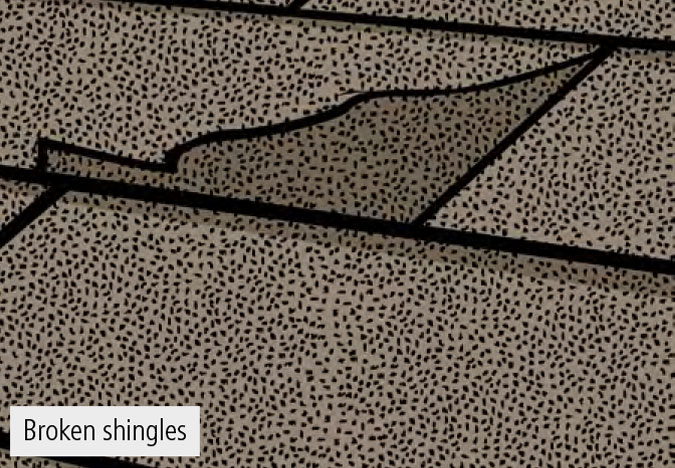 | Broken shinglesBroken shingles can become an entry point for water, especially in areas exposed to the wind. Activities such as walking on the roof or removing snow can damage the shingles, as can improperly installed nails. |
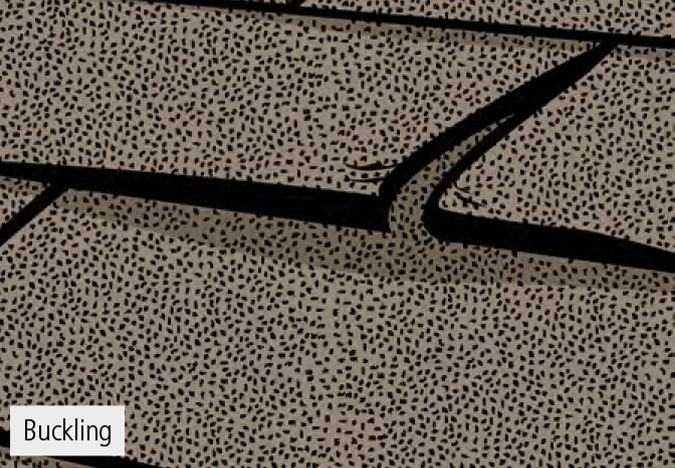 | BucklingShingles that are bulging, with their lower corners curling downward are a sure sign of an aging roof covering that is very vulnerable to inclement weather. The potential causes of such premature wear and tear are dirty adhesive strips that fail to properly stick to the roof, a manufacturing defect, and so on. |
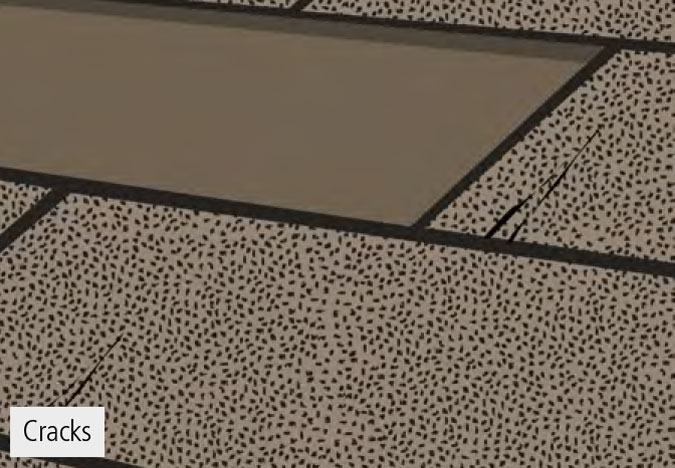 | CrackingAs it ages, the asphalt on the surface of the shingles starts to harden, and the protective granules gradually shed. Fine cracks also begin to form. This is a sign that the roof covering is approaching the end of its useful life. Take a look to see whether it is possible to fix only the damaged shingles. DontLt worry if new shingles are shedding some granules; this is normal. Excess granules will wash away during the first few years. |
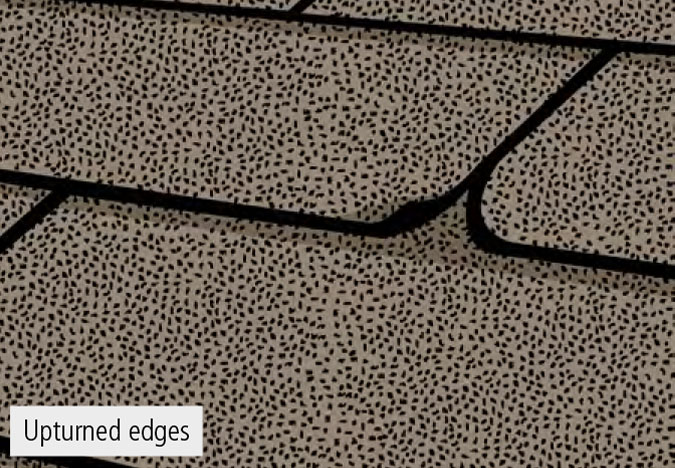 | Upturned edgesShingles with upturned edges become very vulnerable to the wind. Why does this problem occur? There may be several reasons, including excess moisture from a poorly ventilated attic or insufficient adhesive. |
 | SaggingIf the shingle covering is beginning to sag, often indicated by a “wavy” effect, this usually means that there is a problem with the sheathing. This issue must be addressed quickly. |
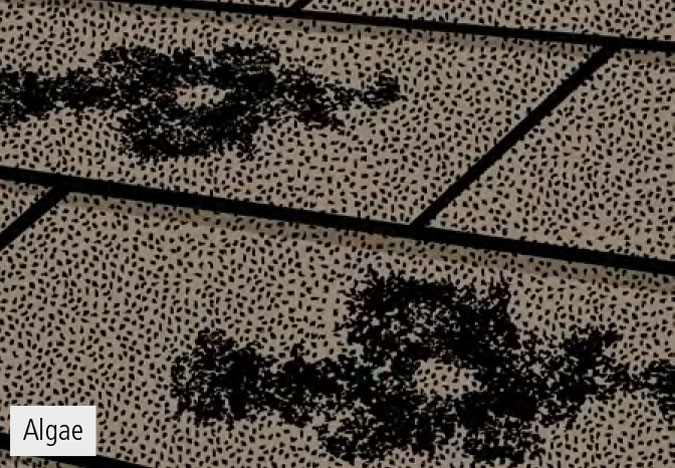 | Algae spotsBrownish and blackish streaks on the shaded areas of the rooftop means that algae are growing on the shingles. This intruder is technically harmless; however, it can be an eyesore, spoiling the aesthetic appeal of the shingles. If the presence of algae bothers you, you can get rid of them with a proper cleaning. |
Take a good look at the condition of the flashing as well: does it properly cover the edges of vents, chimneys and wall junctions? Is any rust visible? Is the flashing still firmly attached? Are any sealant joints cracked or loose? If the answer to any of these questions is “yes,” you’re better off taking corrective action promptly.
Inspecting the roof
When a roof covering shows signs of wear and tear (see the examples illustrated above), a full inspection is a must. You should know that even if the shingles appear to be intact, there could be a surprising amount of damage. Do you know the true condition of your roof?
At this point, you may need advice from a building inspector or contractor. Ask for a comprehensive report so that you know exactly what corrective actions need to be taken.
Focus on decking
During a roof inspection, before giving you the estimate, an experienced roofer can (and should) determine whether the decking needs repairs (whether minor or major). The important thing is to be aware of this possibility so that you don’t get trapped. Once the contract is signed and the roof is stripped, roofers sometimes hit owners with extras, i.e., additional charges for major, urgent work. As a result, consumers are then stuck, for no good reason, because the extra work could habe been foreseen.
Minor repairs include things like:
replacing the nails in the decking;
sealing vulnerable points;
replacing a few boards or small sections of plywood, etc.
A healthy attic is a must to ensure a healthy roof!
There’s no point in replacing shingles if the attic is poorly insulated or ventilated. Any existing problems should therefore be addressed before replacing the roof. Here is what you’ll need to check:
Examine the underside of the decking. Can you any see rusted nails, moisture stains, or mould (which looks like blackened wood)? If so, some boards or panels may need replacing.
Is there insulation properly covering surfaces? Does any insulation seem wet or dried out? Can the thermal resistance factor (“R-value”) be increased by adding more insulation? Is the trapdoor to the attic insulated and airtight? Fix any problem you encounter.
Are the eaves soffits kept clear? If daylight never seems to enter, they are most likely blocked by insulation. If so, it will be necessary to reposition the insulation, and perhaps even to install deflectors to keep the space clear.
Is there a vapour barrier on the ceiling, under the insulation?
With regard to moisture, you should:
insulate all heating, cooling and ventilation ducts passing through the attic;
ensure that no moist or foul air is being released into the attic from the house;
check to see whether any moisture is escaping from ceiling fixtures, recessed lighting or pot lights.
As for major work, it may include:
adding sheets of plywood (or similar material) here and there to strengthen and level the existing decking;
completely replacing the decking (a fairly rare situation).
Remember that it is essential that the contractor inform you in writing, in the estimate, of the planned charge to perform any major repairs that prove necessary.
Decking made from 3⁄8 plywood sheetse
The majority of roof coverings with thin decking eventually warp—if only because of the weight of snow. The most common solution is to strengthen 3⁄8-inch sheathing with a layer of 1/2 plywood. Conversely, adding 3⁄8-inch plywood will reinforce a weakened 1⁄2-inch deck.
Sheathing made from wooden boards
Shingle manufacturers’ warranties will not cover distortion in the covering if it is proved that this is due to sheathing made from wooden boards, which is more prone to warping. Board sheathing is common in houses built before 1960, and this type is more sensitive to humidity variations than plywood sheets. To achieve a smooth surface and maintain your warranty protection, manufacturers recommend adding plywood over the original sheathing; in this case, 3⁄8-inch sheets are sufficient.As for major work, it may include:
adding sheets of plywood (or similar material) here and there to strengthen and level the existing decking;
completely replacing the decking (a fairly rare situation).
Remember that it is essential that the contractor inform you in writing, in the estimate, of the planned charge to perform any major repairs that prove necessary.
Decking made from 3⁄8 plywood sheetse
The majority of roof coverings with thin decking eventually warp—if only because of the weight of snow. The most common solution is to strengthen 3⁄8-inch sheathing with a layer of 1/2 plywood. Conversely, adding 3⁄8-inch plywood will reinforce a weakened 1⁄2-inch deck.
Sheathing made from wooden boards
Shingle manufacturers’ warranties will not cover distortion in the covering if it is proved that this is due to sheathing made from wooden boards, which is more prone to warping. Board sheathing is common in houses built before 1960, and this type is more sensitive to humidity variations than plywood sheets. To achieve a smooth surface and maintain your warranty protection, manufacturers recommend adding plywood over the original sheathing; in this case, 3⁄8-inch sheets are sufficient. Note that you are under no requirement to accept, but if you do say no, the roofer wil no doubt ask you tou comfirm that decision in writing in tne contract, to avoid any possibility of legal action.
Do you need personalized advice on your home?
Our Residential Advisory Services counsellors are there to answer your questions and support you when you need it. Ask for their advice as often as you like. It’s one of the benefits of membership.
